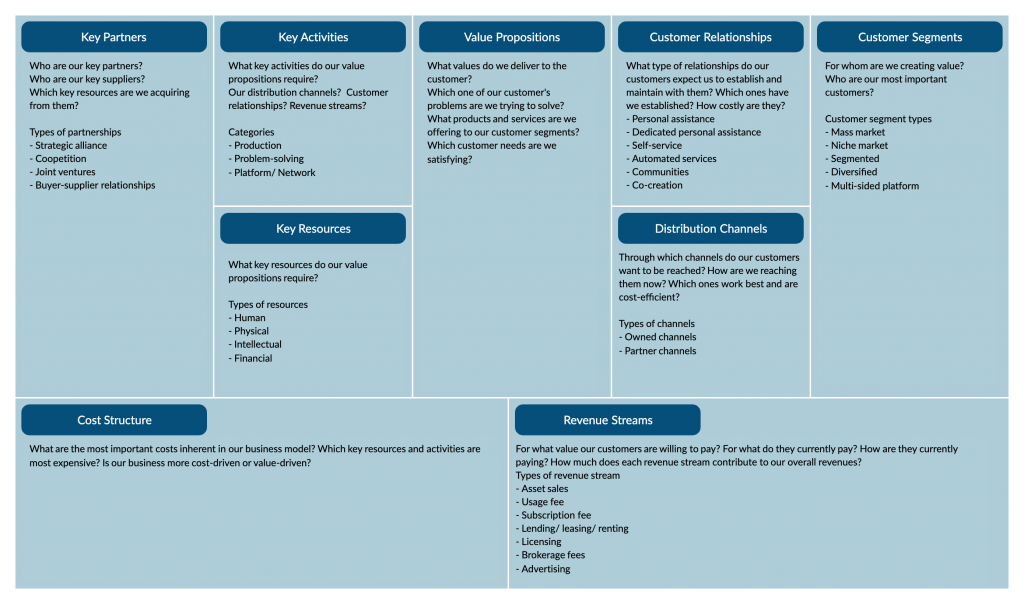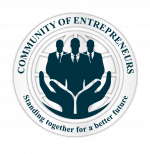A business model is simply a plan describing how a business intends to make money. It explains who your customer base is and how you deliver value to them and the related details of financing.
It’s a one-page document containing nine boxes that represent different fundamental elements of a business.
It beats the traditional business plan that spans across several pages, by offering a much easier way to understand the different core elements of a business.

How to use it?
Value Proposition:
The value proposition is the most crucial part in terms of how a product/service may benefit others and what is its added value.
Usually, it is a solution for a certain issue or pain points that are tackled and addressed by your business for your client’s wellbeing.
Good questions to ask when defining your business/product:
- What is the problem I am solving?
- Why would someone want to have this problem solved?
- What is the underlying motivator for this problem?
Customer Segments
The segmentation process is the practice of classifying customers into different categories according to specific criteria such as age, gender, interest and spending habits..
Things to consider when determining your Customer Segments:
- Who are we solving the problem for?
- Who are the people that will value my value proposition?
- Are they another business?
- If so, what are the characteristics of those businesses?
- Or, are they other people?
- Does my value proposition appeal to men/women or both?
- Does it appeal to young adults aged 20 to 30 or teenagers?
- What are the characteristics of the people who are looking for my value proposition?
Market size is also a factor to consider along with the number of people in the customer segment.
Studying it will result in a better understanding of the market niche form a Micro and Macro environment.
As a start, it is advisable to begin with creating customer personas for each of the customer segments.
Customer Relationships
The customer relationships is a holistic study of the company’s interaction and communication plan with its further customer personas that are already created and revised.
Some of the useful questions to consider are: Will you run an online business? What platform will you use? How are you going to contact the clients? Over the phone? Are you willing to meet in person?
One can mention an important tool used in this study which is creating a User Journey Map of the customer and their communication with the business.
This will help identify the meeting points/ tools between the business and the target customers and provide a good strategic approach in terms of the company’s operations and precise opportunities for automation.
Channels
The channels part tackles the marketing plan of the business as a whole.
It works on precising the avenue through which your clients contact and interacts with the business and its integration into the sales cycle.
Good questions to ask when identifying the channels to reach your customers are:
- How are you going to tell your customer segment about your value proposition?
- Where are your customers?
- Are they on social media?
- Are they driving their car and listening to the radio?
- Are they at an event or conference?
- Do they watch TV at 7pm on a Friday night?
Understanding how to reach your customers is so crucial to your business.
Key Activities
These are the crucial activities of the business that participate in achieving the value proposition for the customers and guarantee their satisfaction.
Questions to ask:
- What activities does the business undertake in achieving the value proposition for the customer?
- What is the resource used?
- Time?
- Expertise?
- Distribution of product?
- Technical development?
- Strategy?
- Offer resources (human/physical)?
- What actions does it take you and/or your staff to achieve value exchange?
Key Resources
These are the crucial resources and the start point of the business’ production activity.
That is, this is a group of resources required to achieve the key activities of the company in the most optimal way.
These resources are what is needed practically to undertake the action/activities of your business:
- Office space
- Computers
- Hosting
- People (staff)
- Internet connection
- Car
- Bike
- Oven
- Electricity
- Car Parts
Key Partners
The key partners are the external parts of the business relied ecosystem. That is, they have a direct impact on the company’s performance and activity such as suppliers, other companies/parties and whose role is crucial to deliver the promised added value to the clients.
One of the key questions to ask in this part is : “who do I rely on to achieve my business value proposition?” As a specific example, one may ask ‘if I sell groceries to customers, I may need a local baker to supply fresh read to my store’.
Cost Structures
Your business cost structure is defined as the monetary cost of operating as a business.
- How much does it cost to achieve my businesses key activities?
- What are the cost of my key resources and key partnerships?
- How much does it cost to achieve the value proposition for my customers/users?
- Are there additional costs to running a business?
- Legal?
- Insurance?
- What is the cost of my business?
- It is important also to place a monetary value on your time as a cost.
- How much would it cost you to hire you?
- What is the opportunity cost of running your business?
Revenue Streams
The revenue streams are the paths through which a business intends to convert the value proposition/ solution provided to the customers that tackles a specific issue into financial gain and profit.
This may be done only if a full understanding of pricing is present while the establishment of those ways. In other terms, the firm needs to balance between the proposed price and the weight of the proposed value through the product/service.
There are many different revenue models here:
- Pay per product (pay per view)
- Fee for service
- Fixed rate
- Subscription
- Dividends
- Referral feeds
- Freemium
- Equity gain
| References |
| 1. Business Plan: Business Model Canvas, accessed October 2020, https://expertprogrammanagement.com/2018/10/business-model-canvas-explained/ |

Leave A Comment?